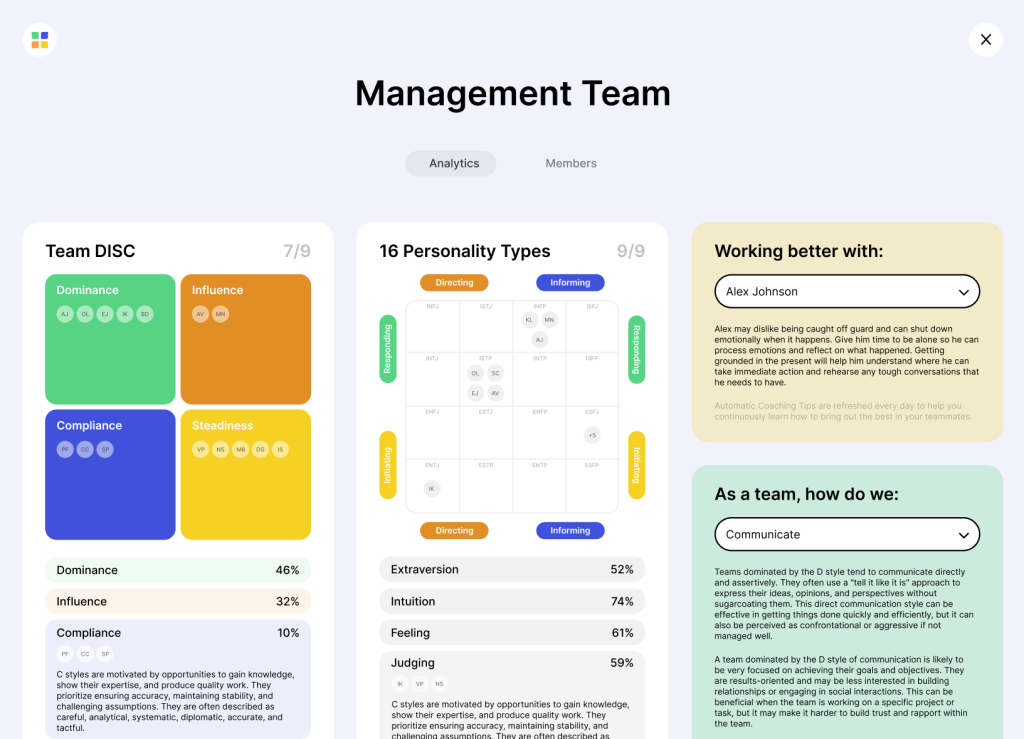ISTP personality, also known as a virtuoso, crafter, or detective, is one of the 16 MBTI personality types. ISTP is an acronym for these four basic personality types: introversion (I), sensing (S), thinking (T), and perceiving (P).
People with this personality type are explorers which is why they are also called detectives. They’re open to new experiences and enjoy the action and dynamics in everyday life.
Virtuosos are individualistic people who constantly try to pursue their goals without paying attention to traditional structures and social norms. They are strongly independent, self-confident, and action-oriented people.
Although all crafters share the basic personality types, understanding the difference between ISTP subtypes – assertive virtuosos (ISTP-A) and turbulent virtuosos (ISTP-T) is helpful to predict their behavior in different situations.
In this article, we will compare assertive and turbulent virtuosos, distinguish their behavior in various types of relationships, discuss their strengths and weaknesses and talk about the best and worst career paths for them.
Differences Between ISTP-A and ISTP-T
As a result of having the same personality traits, assertive and turbulent virtuosos share many habits, values, attitudes, or thinking patterns. However, sometimes they experience similar things in different ways. Their levels of self-confidence are quite different as well.
Assertive virtuosos are self-assured people who don’t hesitate to take risks while turbulent virtuosos prefer to estimate possible outcomes, instead. In this section, we will compare ISTP-A and ISTP-T personality subtypes by friendships, romantic relationships, workplace habits, and teamwork skills.
Friendships
People with ISTP personalities easily make new friends. Even though they are introverts, ISTPs have great communication skills. They enjoy discovering others’ interests and exploring if they share some hobbies with their acquaintances.
Their open-mindedness helps ISTPs to become popular among their peers. However, often they lack deep emotional connections with their friends.
Assertive virtuosos easily accept their friends with their strengths and weaknesses. They don’t try to compare themselves to their friends. In friendships, they value shared hobbies and mutual interests.
Turbulent virtuosos aim to explore the world alongside their friends.
They tend to seek new hobbies too often in order to meet new people and find new opportunities. They often get bored of being around the same people all the time and try to gain friends in all types of new situations.
Relationships
Independent, fun-loving, and adventurous are some of the adjectives that can be used for describing ISTP in relationships. The Detectives often have trouble expressing their feelings and emotions.
However, it doesn’t mean they don’t take care of their partners. In fact, both ISTP-A and ISTP-T tend to try to keep their relationships alive by taking part in various engaging activities with their partners.
Assertive Crafters are more likely to control their emotions in relationships than Turbulent ones. Usually, they wait for their partners to express love and warmth. People with ISTP-A personalities build romantic relationships based on mutual attitudes or interests as they believe emotions are temporary, devaluing their significance in relationships.
Unlike the ISTP-A subtype, Turbulent Crafters are more passionate. They also require personal space in relationships but they are more open with their partners and sometimes even enjoy sharing their feelings.
Workplace
Crafters usually feel very confident at the workplace. Since they enjoy unpredictability, they tend to feel comfortable even if the work is very challenging.
Actually, they prefer complex tasks because ISTPs believe that difficulty is a key to growth. And they value the opportunity to develop professionally. However, there are some specific differences between assertive and turbulent virtuosos in the way they perceive the workplace.
Assertive ISTPs are more confident at the workplace than turbulent ones. People with ISTP-A personalities easily express their competence in actions and don’t hesitate to state their opinions out loud. They’re not afraid even when things don’t go right as they realize mistakes help them to grow.
Turbulent ISTPs feel less comfortable about their competencies and skills at the workplace. They find it difficult to concentrate when things don’t go exactly as they planned. Besides, unlike assertive virtuosos, they’re usually concerned about “fitting in” at the workplace. However, they somehow find efficient ways to deal with challenges or adapt to changes.
Working in a Team
Even though ISTPs are great communicators, they prefer action to the discussion. As a result, instead of interacting with their teammates and participating in long discussions, they get things done.
However, due to their flexible nature, assertive and turbulent virtuosos easily take part in conversations, state their opinions, and critically assess the ways of developing effective solutions to collective problems.
Assertive virtuosos often play the role of leader while working in a team. They are self-confident individuals who never worry about fitting in with the team. Due to their creative abilities and intelligence, they often stand out from other team members.
Turbulent virtuosos are less likely to manage the team. They don’t really enjoy working in teams as they’re ambitious people who prefer to succeed on their own instead of sharing their thoughts and opinions with others.
ISTP-A Strengths and Weaknesses
ISTPs are practical and realistic people with flexible attitudes towards life. However, people with this personality type also have some character flaws such as being impatient, impulsive and having trouble expressing feelings.
All these ISTP strengths and ISTP flaws apply to both ISTP-A and ISTP-T subtypes. But these characteristics are revealed in different ways in the behaviors of Assertive and Turbulent Virtuosos.
Here are the main personality strengths of the ISTP-A subtype:
- Confidence – Assertive Virtuosos are confident about their skills and knowledge. Due to their strong self-confidence, they don’t hesitate to state their opinions firmly and publicly even in front of strangers.
- Great coping mechanisms – Assertive Virtuosos have powerful coping strategies. Instead of using maladaptive coping mechanisms that increase stress and anxiety, ISTP-As proactively deal with problems.
- Self-control – emotions rarely control assertive ISTP’s behaviors. They maintain a sense of control over their lives even when they are faced with overwhelming problems.
On the other hand, as a result of their Assertive nature, people with ISTP-A personality subtype often have the following personality weaknesses:
- Lack of empathy – Assertive Virtuosos find it hard to understand other people’s emotions. As a result, sometimes they are perceived as insensitive people at a first glance.
- Overly ambitious – Assertive Virtuosos have a very strong desire to succeed. But being too ambitious makes them sensitive to failures. Also, as a result of their ambition, they are at risk of burnout.
- Don’t think about the future – Assertive Virtuosos are too focused on the present moment. They don’t set plans for the future and consequently, sometimes they aren’t properly prepared for possible changes.
ISTP-T Strengths and Weaknesses
Turbulent Virtuosos also have some specific personality strengths and weaknesses that distinguish them from Assertive ISTPs and other MBTI personality types. These characteristics are determined by their turbulent nature, unsettled emotions, and lack of confidence.
Here are the main strengths of ISTP-T personality that they should count on in order to flourish:
- Tendency to explore the world – turbulent virtuosos are very curious people. They have a strong desire to explore the world around them and enjoy trying new activities or developing new hobbies.
- Desire to grow – growth is one of the major motivators for people with ISTP-T personalities. They aren’t satisfied with their current selves and always try to develop new skills or learn new things.
- Great social skills – turbulent virtuosos have better communication skills compared to assertive ones. Although they are introverts and prefer to be on their own, they can naturally interact with people. Social situations don’t stress the ISTP-T subtype.
However, Turbulent personality characteristics also determine some personality flaws for the ISTP-T personality subtype:
- Self-doubt – unlike assertive virtuosos, turbulent ones lack self-confidence. They tend to doubt themselves about their abilities and knowledge especially when they make mistakes.
- Subjects of social pressure – people with ISTP-T personalities are more concerned about their social life than ISTP-As. Therefore, they are often influenced by other people and have a tendency to conform with other people.
- Chaotic emotions – turbulent virtuosos experience a wide range of different emotions from anger to pleasure. They can’t control their emotions and consequently, their decisions tend to be impulsive.
Jobs and Career Paths for ISTP-T
Generally, most ISTP job paths are accompanied by opportunities for growth because both assertive and turbulent virtuosos value professional development. People with an ISTP-T personality are motivated to use their skills and expertise in order to achieve their goals.
It doesn’t matter whether it’s a traditional job or a modern one, as long as it gives them an opportunity of development and ability to actualize their ideas, it’s suitable for turbulent crafters.
List of 10 Most Recommended Jobs for ISTP-Ts
- Systems analyst
- Software Developer
- Police officer
- Fitness trainer
- Financial manager
- Detective
- Animal trainer
- Dental assistant
- Criminal investigator
- Insurance examiner
7 Jobs and Career Paths That ISTP-T Should Avoid
Here are 7 jobs that aren’t recommended to do as ISTP-T:
- Market researcher
- Receptionist
- Preschool teacher
- Occupational therapist
- Veterinary technician
- Writer
- Entrepreneur
Jobs and Career Paths for ISTP-A
List of 10 Recommended Jobs for ISTP-As
- Photographer
- Scientist
- Engineering
- Forensic Science
- Pilot
- Machinist
- Chef
- Physician
- Coach
- Driver
List of 7 Jobs and Career Paths That ISTP-A Should Avoid
- Actor
- Journalist
- Reporter
- Social worker
- Psychologist
- Pediatrician
- School teacher
ISTP-A And ISTP-T FAQs
Are ISTP-T and ISTP-A the same?
No, ISTP-T and ISTP-A are different subtypes of the ISTP personality. Even though they are both identified as one personality type, there are significant differences between Assertive and Turbulent personality subtypes. In fact, Assertive Virtuosos (ISTP-A) tend to be more confident than Turbulent Virtuosos (ISTP-T).
Turbulent subtypes, on the other hand, often doubt themselves and find it hard to make strong decisions without overthinking. In general, Turbulent ISTPs are impatient individuals while Assertive ISTPs are stable, independent people.
ISTPs in general make up about 5.4% of the general population. This means that they’re neither very rare nor very common. To be more exact, the ISTP personality is the 8th most common personality type among the 16 MBTI types.
However, when it comes to ISTP subtypes, needless to say, they are rare. While there is no official data about the percentage of ISTPs in the general population, it’s clear that ISTP-A and ISTP-T make up less than 5.4% of the total population.
ISTP and ISTP aren’t ideal pairs, but according to the MBTI compatibility charts, they have plenty of chances to get along. The reason is that ISTPs usually prefer interacting with introverted (I) people who prefer logic to feelings.
Since ISTPS can spend hours arguing about abstract things, they get along with each other very well. Therefore, the opinion that two individuals with similar personality types can’t be compatible is just a myth, and everything depends on the specific situation.


